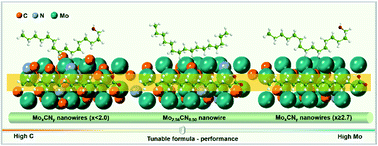Engineering the structural formula of N-doped molybdenum carbide nanowires for the deoxygenation of palmitic acid†
Abstract
Molybdenum carbides are known to be promising substitutes for noble metals used in the upgradation of bio-oil. The catalytic properties depend on the structure and heteroatom modification significantly. Herein, N-doped molybdenum carbide (MoxCNy) nanowires were synthesized at a very low temperature (≤500 °C) by the one-step pyrolysis of an Mo-based organic–inorganic hybrid (Mo-3atrz) for the first time. The relationship between the structural formula and performance of the as-prepared MoxCNy nanowires in the deoxygenation of palmitic acid was explored. The conversion of palmitic acid over the MoxCNy nanowires proceeds mainly via the hydrodeoxygenation route: palmitic acid → hexadecanal → hexadecanol → hexadecene → hexadecane. Adjusting “x” and “y” in the MoxCNy nanowires efficiently changes their intrinsic electron distribution and leads to electron transfer within Mo, C and N, thus resulting in alterable MoxCNy properties. The connection between the regioselective cleavage of the C–O bonds and the structural formula of MoxCNy is verified. Mo2.56CN0.50 with an optimized formula exhibits excellent activity (99.6% conversion of palmitic acid) and 99.2% selectivity to alkanes.



 Please wait while we load your content...
Please wait while we load your content...